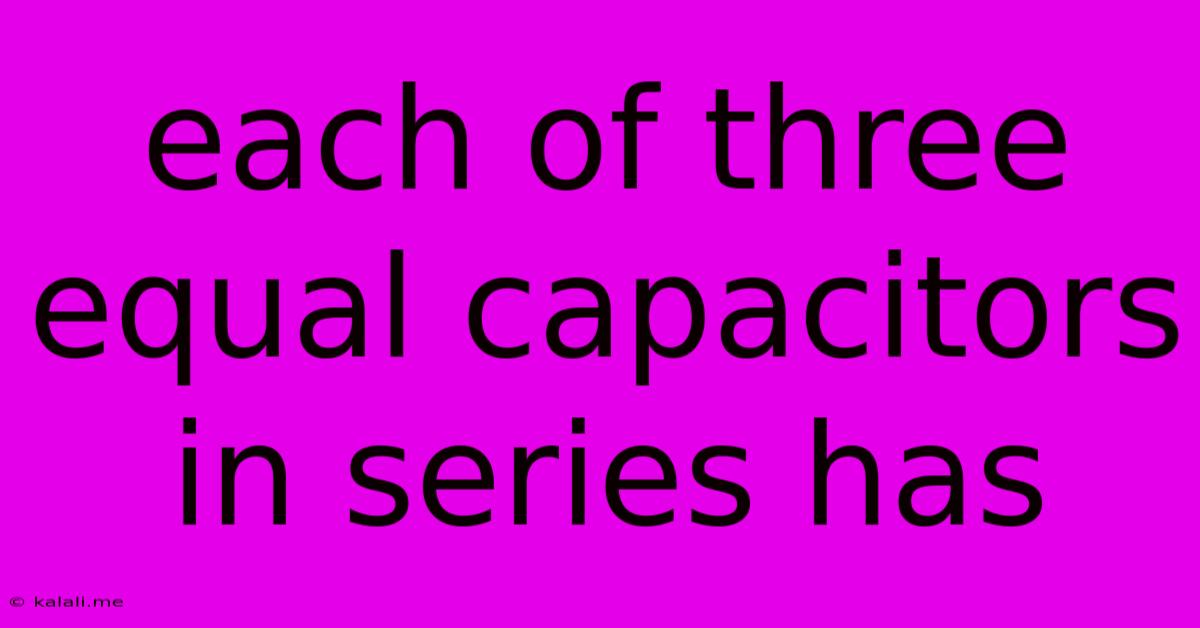Each Of Three Equal Capacitors In Series Has
Kalali
Jun 14, 2025 · 2 min read

Table of Contents
Three Equal Capacitors in Series: Understanding the Equivalent Capacitance
This article explores the behavior of three equal capacitors connected in series, focusing on calculating their equivalent capacitance and understanding the implications for circuit design. Understanding series capacitor configurations is crucial for electronics and electrical engineering students and professionals alike. We'll delve into the calculations and explain the underlying principles.
What Happens When Capacitors are Connected in Series?
Unlike resistors, where the total resistance increases when components are connected in series, the total capacitance decreases when capacitors are connected in series. This is because the effective plate separation increases, reducing the overall capacitance. Think of it like this: each capacitor acts as a barrier to charge flow, and the total barrier is the sum of the individual barriers.
Calculating Equivalent Capacitance for Three Equal Capacitors in Series
Let's assume we have three identical capacitors, each with capacitance C. The formula for calculating the equivalent capacitance (C<sub>eq</sub>) of capacitors in series is:
1/C<sub>eq</sub> = 1/C₁ + 1/C₂ + 1/C₃ + ...
Since our capacitors are equal, the formula simplifies to:
1/C<sub>eq</sub> = 1/C + 1/C + 1/C = 3/C
Therefore, the equivalent capacitance is:
C<sub>eq</sub> = C/3
This means that the equivalent capacitance of three equal capacitors connected in series is one-third the capacitance of a single capacitor. This is a fundamental concept in circuit analysis.
Implications and Applications
The reduced equivalent capacitance in series configurations has several important implications:
- Reduced Energy Storage: The total energy stored in the series combination is less than the energy stored in a single capacitor.
- Increased Voltage Rating: A key advantage is that the voltage rating of the equivalent capacitance increases. Each capacitor in the series shares the total voltage applied across the combination. This allows for the use of lower-voltage capacitors in high-voltage applications. This is a practical application often utilized in power supplies and high-voltage circuits.
- Circuit Design Considerations: This reduced capacitance needs to be considered when designing circuits involving filtering, timing, or energy storage. Accurate capacitance calculations are essential for achieving the desired circuit behavior.
Example Calculation:
Let's say each of our three capacitors has a capacitance of 10 µF (microfarads). The equivalent capacitance would be:
C<sub>eq</sub> = 10 µF / 3 ≈ 3.33 µF
This simple calculation highlights the significant reduction in capacitance when connecting capacitors in series.
Conclusion:
Understanding the behavior of capacitors connected in series is a critical aspect of circuit analysis and design. The equivalent capacitance of three equal capacitors in series is simply one-third the capacitance of a single capacitor. This principle, coupled with an understanding of voltage division in series circuits, allows for efficient and safe circuit design involving higher voltage applications. Remember to always consider the implications of reduced capacitance when incorporating series capacitor configurations into your projects.
Latest Posts
Latest Posts
-
Example Of Solid Dissolved In Solid
Jun 14, 2025
-
Air Pressure At Sea Level Is Equal To
Jun 14, 2025
-
What Is The Opposite Of Reluctant
Jun 14, 2025
-
Brass Is A Mixture Of What
Jun 14, 2025
-
Which Of The Following Are Pure Substances
Jun 14, 2025
Related Post
Thank you for visiting our website which covers about Each Of Three Equal Capacitors In Series Has . We hope the information provided has been useful to you. Feel free to contact us if you have any questions or need further assistance. See you next time and don't miss to bookmark.